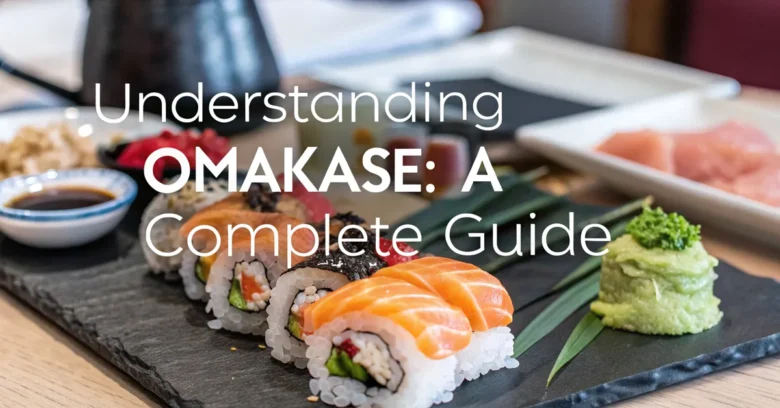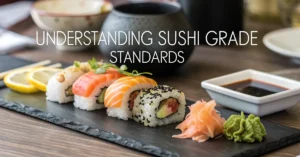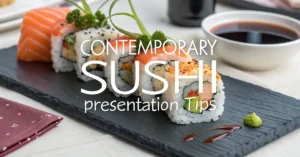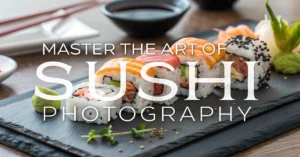Omakase dining: It’s the ultimate trust fall for foodies. You walk into a sushi restaurant, sit down, and surrender your culinary fate to the chef. But what exactly is omakase, and is it worth the splurge?
Let’s be real, omakase can sound intimidating. Is it just expensive sushi? Are there unspoken rules? Will I accidentally insult the chef? This guide will demystify omakase dining, turning you from a curious observer into a confident participant ready to savor every bite.
We will explore the history of omakase, what makes it unique, and how to navigate this special dining experience. By the end, you’ll know what to expect, how to appreciate the chef’s artistry, and whether an omakase experience fits your budget and palate. Let’s dive in and unlock the secrets of omakase.
What Is Omakase Dining?
Omakase (お任せ) translates to “I leave it to you.” It’s a Japanese dining style where you, the diner, relinquish control of the menu to the chef. Instead of ordering à la carte, you’re presented with a curated progression of dishes selected by the chef based on seasonality, availability, and their own creative vision.
Think of it as a personalized tasting menu where the chef showcases their expertise and the freshest ingredients. This isn’t just about eating sushi; it’s about experiencing a culinary journey.
Key Characteristics of Omakase
- Chef’s Choice: The chef determines the menu, often highlighting seasonal ingredients and unique preparations.
- Trust and Respect: Omakase relies on a relationship of trust between the diner and the chef. You are trusting their expertise, and in turn, you show respect for their craft.
- Interactive Experience: Omakase is often served at a sushi counter, allowing you to watch the chef prepare each dish and learn about the ingredients. This creates a more personal and engaging dining experience.
- Emphasis on Freshness and Quality: Chefs typically source the highest quality ingredients, often flown in daily, to create the best possible flavors.
- Artistic Presentation: Omakase is not just about taste; it’s also about visual appeal. Dishes are carefully arranged to create a beautiful and harmonious presentation.
What to Expect in an Omakase Experience
A typical omakase experience begins with a greeting and a brief conversation with the chef. This allows the chef to gauge your preferences, dietary restrictions, and any allergies. Don’t be afraid to speak up!
The meal then unfolds as a series of small, thoughtfully prepared dishes. These often include:
- Zensai (Appetizers): Small, flavorful bites to stimulate the appetite. These might include marinated vegetables, tofu, or small seafood preparations.
- Sashimi: Slices of raw fish served with minimal accompaniments to highlight their natural flavor and texture.
- Nigiri: Hand-pressed sushi featuring various types of fish and seafood. The chef carefully balances the rice (shari) and the topping (neta) for optimal flavor.
- Yakimono (Grilled Dishes): Grilled fish or meat, often prepared with simple seasonings to enhance their natural flavors.
- Agemono (Fried Dishes): Lightly battered and deep-fried seafood or vegetables, offering a contrasting texture.
- Soup: A clear broth or miso soup to cleanse the palate.
- Dessert: A light and refreshing dessert, such as fruit or mochi, to end the meal.
The order and specific dishes will vary depending on the chef’s preferences, the season, and the availability of ingredients. Be open to trying new things, and trust that the chef will guide you through a memorable and delicious experience.
The History and Evolution of Omakase
Omakase’s origins are rooted in practicality and a shift in dining culture. In the past, sushi restaurants often lacked clear pricing, leading to uncertainty for diners. Omakase emerged as a way to offer transparency and value. By entrusting the chef, customers knew they would receive a high-quality, curated meal, often at a set price.
Over time, omakase evolved beyond mere convenience and became a showcase for culinary artistry. Chefs embraced the opportunity to express their creativity, experiment with new ingredients, and connect with diners on a more personal level.
From Practicality to Culinary Art
- Early Days: Initially, omakase was a solution to pricing ambiguity, offering a defined experience for a set cost.
- Rise of the Sushi Chef: As sushi chefs gained recognition for their skill and knowledge, omakase became a way for them to highlight their expertise.
- Emphasis on Seasonality: Omakase embraced the concept of “shun” (旬), the peak season for ingredients, reflecting a deeper appreciation for natural flavors.
- Globalization of Sushi: As sushi gained popularity worldwide, omakase became a symbol of authentic and high-end Japanese dining.
- Modern Omakase: Today, omakase is a sophisticated culinary experience that blends tradition with innovation, showcasing both the chef’s skill and the finest ingredients.
How Omakase Differs from Traditional Sushi Ordering
While both involve enjoying sushi, omakase and à la carte dining offer distinct experiences.
| Feature | Omakase | Traditional Sushi Ordering |
| —————– | ————————————- | ——————————— |
| Menu Control | Chef determines the dishes | Diner selects from a menu |
| Ingredient Focus | Seasonal, high-quality, unique items | Common sushi ingredients |
| Dining Style | Multi-course tasting menu | Individual pieces or rolls ordered |
| Price | Typically higher, set price | Varies depending on selection |
| Chef Interaction | Direct interaction, personalized | Limited interaction |
| Experience | Culinary journey, artistic | More casual, focused on specific items |
Choosing between omakase and traditional ordering depends on your preferences and budget. If you’re looking for a guided culinary adventure and are willing to trust the chef, omakase is an excellent choice. If you prefer to stick to familiar favorites and control your spending, à la carte dining might be more suitable.
Navigating the Omakase Experience: A Diner’s Guide
Stepping into an omakase restaurant can be daunting, especially for first-timers. Here’s a guide to help you navigate the experience with confidence and ensure you get the most out of your meal.
Before You Go
- Research the Restaurant: Read reviews and look at photos to get a sense of the restaurant’s style, price range, and the chef’s reputation.
- Check the Price: Omakase menus can vary significantly in price. Make sure the restaurant fits your budget.
- Make a Reservation: Omakase seating is often limited, so book in advance, especially for popular restaurants.
- Note Dietary Restrictions: When making your reservation, inform the restaurant of any allergies or dietary restrictions. This allows the chef to plan accordingly.
During the Meal
- Be Punctual: Arrive on time for your reservation to show respect for the chef and other diners.
- Engage with the Chef: Don’t be afraid to ask questions about the ingredients, preparations, or the chef’s philosophy.
- Communicate Your Preferences: While you’re entrusting the chef, it’s okay to express preferences for certain types of fish or flavors. However, be open to trying new things.
- Observe Proper Etiquette: Use chopsticks correctly, avoid strong perfumes, and refrain from talking loudly or using your phone excessively.
- Savor Each Bite: Take your time to appreciate the flavors, textures, and presentation of each dish.
- Express Your Appreciation: At the end of the meal, thank the chef for their artistry and the enjoyable experience.
Etiquette Tips for Omakase Dining
- Use Chopsticks Correctly: Avoid pointing with your chopsticks, sticking them upright in your rice, or passing food directly from chopstick to chopstick.
- Eat Nigiri Upside Down: Dip the fish (neta) side of the nigiri into the soy sauce, rather than the rice (shari) side, to avoid soaking the rice.
- No Wasabi in Soy Sauce: Adding wasabi to your soy sauce is generally frowned upon. The chef will typically add the appropriate amount of wasabi to each piece of sushi.
- Eat Ginger as a Palate Cleanser: Use the pickled ginger (gari) to cleanse your palate between different types of fish.
- Avoid Over-Seasoning: The chef has carefully seasoned each dish, so avoid adding excessive soy sauce or other condiments.
Handling Dietary Restrictions and Preferences
It’s crucial to communicate any allergies or dietary restrictions to the restaurant when making your reservation. This allows the chef to plan the menu accordingly and ensure your safety.
- Allergies: Clearly state any allergies, such as shellfish, nuts, or gluten.
- Dietary Restrictions: Inform the restaurant of any dietary restrictions, such as vegetarian, vegan, or pescatarian.
- Preferences: While omakase is about trusting the chef, it’s okay to express preferences for certain types of fish or flavors. However, be open to trying new things.
- Be Specific: Provide as much detail as possible about your restrictions or preferences. This helps the chef tailor the experience to your needs.
- Don’t Be Afraid to Ask: If you’re unsure about an ingredient, don’t hesitate to ask the chef for clarification.
Remember, communication is key to a successful omakase experience. By being upfront about your needs and preferences, you can ensure that the chef creates a meal that is both delicious and safe for you to enjoy.
The Chef’s Perspective: Crafting an Omakase Menu
For sushi chefs, omakase is more than just a job; it’s an art form. It’s a chance to express their creativity, showcase their skills, and connect with diners on a personal level.
Sourcing and Selecting Ingredients
Chefs prioritize freshness and quality when selecting ingredients for their omakase menus. This often involves:
- Direct Relationships with Suppliers: Chefs often cultivate relationships with fishermen, farmers, and other suppliers to ensure access to the best possible ingredients.
- Seasonal Sourcing: Ingredients are selected based on their peak season, ensuring optimal flavor and texture.
- Daily Deliveries: Many restaurants receive daily deliveries of fresh fish and seafood, often flown in from around the world.
- Eye for Quality: Chefs possess a trained eye for quality, carefully inspecting each ingredient to ensure it meets their high standards.
The Art of Balancing Flavors and Textures
Creating a balanced and harmonious omakase menu requires careful consideration of flavors, textures, and presentation. Chefs strive to:
- Contrast and Complement: Dishes are designed to offer a variety of flavors and textures that complement each other, creating a multi-sensory experience.
- Highlight Natural Flavors: Chefs use minimal seasonings to enhance the natural flavors of the ingredients, rather than masking them.
- Create Visual Appeal: Dishes are carefully arranged to create a beautiful and harmonious presentation, appealing to both the palate and the eye.
- Tell a Story: The omakase menu is often designed to tell a story, showcasing the chef’s personal style and the seasonality of the ingredients.
The Importance of the Chef-Diner Relationship
Omakase relies on a relationship of trust and respect between the chef and the diner. Chefs value:
- Open Communication: Chefs appreciate diners who are willing to engage in conversation, ask questions, and express their preferences.
- Respect for the Craft: Diners who show appreciation for the chef’s skill and the quality of the ingredients are highly valued.
- Willingness to Experiment: Chefs appreciate diners who are open to trying new things and stepping outside of their comfort zones.
- Positive Feedback: Chefs appreciate positive feedback and enjoy seeing diners savor and appreciate their creations.
By fostering a positive and respectful relationship with their diners, chefs can create a truly memorable and rewarding omakase experience for everyone involved.
Omakase Around the World: Variations and Regional Styles
While the core principles of omakase remain consistent, regional variations and styles have emerged, reflecting local ingredients, culinary traditions, and chef’s preferences.
Sushi Styles
- Edomae Sushi: Originating in Tokyo (formerly Edo), Edomae sushi emphasizes traditional techniques and locally sourced ingredients. It often features fish that is cured, marinated, or cooked in some way to enhance its flavor.
- Kansai-Style Sushi: Popular in Osaka and Kyoto, Kansai-style sushi often incorporates pressed sushi (oshizushi) and vinegared mackerel (battera). It tends to be sweeter and more colorful than Edomae sushi.
- Kyushu Sushi: From the island of Kyushu, this style of sushi emphasizes fresh, local seafood and unique preparations. It often features ingredients like sea urchin (uni) and horse mackerel (aji).
- American Sushi: Incorporates creative ingredients like avocado, cream cheese, and spicy mayonnaise. Although frowned upon by sushi purists, it contributed to the popularization of sushi worldwide.
Beyond Japan: International Interpretations of Omakase
- North America: Omakase in North America often features a wider range of ingredients and preparations, reflecting the diversity of local cuisine.
- Europe: European omakase restaurants often blend Japanese techniques with local ingredients and culinary styles.
- South America: South American omakase menus often incorporate local seafood and tropical fruits, creating a unique fusion of flavors.
- Australia: Australian omakase restaurants often highlight local seafood and indigenous ingredients, showcasing the country’s unique culinary landscape.
These regional variations demonstrate the adaptability and evolution of omakase, as chefs around the world put their own spin on this traditional dining style.
The Cost of Omakase: Is It Worth the Splurge?
Omakase is generally more expensive than traditional sushi ordering due to the higher quality ingredients, the chef’s expertise, and the personalized dining experience. However, the question of whether it’s “worth it” is subjective and depends on your individual preferences and budget.
Factors Influencing Omakase Pricing
- Ingredient Quality: Omakase restaurants typically use the highest quality ingredients, often flown in daily from around the world.
- Chef’s Expertise: The chef’s skill and experience play a significant role in the price of an omakase menu.
- Location: Omakase restaurants in major cities or tourist destinations tend to be more expensive.
- Restaurant Ambiance: The ambiance and decor of the restaurant can also influence pricing.
- Number of Courses: Longer omakase menus with more courses tend to be more expensive.
Weighing the Value Proposition
To determine if omakase is worth the splurge, consider the following:
- Quality of Ingredients: Are you willing to pay a premium for the freshest and highest quality ingredients?
- Culinary Experience: Do you value a personalized and interactive dining experience?
- Chef’s Artistry: Are you interested in experiencing the chef’s creativity and skill?
- Budget: Can you comfortably afford the cost of the omakase menu?
- Personal Preferences: Do you enjoy trying new things and trusting the chef’s expertise?
If you value these factors, omakase can be a worthwhile investment. However, if you’re on a tight budget or prefer to stick to familiar favorites, traditional sushi ordering might be a better option.
Alternatives to Omakase for Sushi Enthusiasts
If you’re looking for a more affordable way to enjoy high-quality sushi, consider the following alternatives:
- Lunch Specials: Many sushi restaurants offer lunch specials that feature a selection of nigiri or rolls at a lower price.
- Happy Hour: Some sushi restaurants offer discounted sushi and drinks during happy hour.
- Sushi Sets: Order a sushi set or combination platter to sample a variety of different types of sushi.
- À la Carte Ordering: Order individual pieces of nigiri or rolls that you enjoy, rather than committing to a full omakase menu.
- DIY Sushi: Make your own sushi at home using fresh ingredients.
Ultimately, the best way to enjoy sushi is the way that best suits your preferences and budget.
Finding the Right Omakase Restaurant for You
With the increasing popularity of omakase, there are now numerous restaurants offering this dining style. Here’s how to find the right one for you:
Research and Reviews
- Online Reviews: Read reviews on sites like Yelp, Google Reviews, and TripAdvisor to get a sense of the restaurant’s quality, price, and ambiance.
- Food Blogs and Articles: Look for articles and blog posts written by food critics or local food enthusiasts.
- Social Media: Check out the restaurant’s social media pages to see photos of their dishes and get a sense of their style.
Consider Your Budget and Preferences
- Price Range: Omakase menus can vary significantly in price. Make sure the restaurant fits your budget.
- Cuisine Style: Do you prefer traditional Edomae sushi or a more modern and innovative approach?
- Ambiance: Do you prefer a formal and upscale setting or a more casual and relaxed atmosphere?
- Location: Choose a restaurant that is conveniently located for you.
Ask for Recommendations
- Friends and Family: Ask friends or family members who have enjoyed omakase for their recommendations.
- Sushi Experts: Seek out recommendations from sushi chefs, food critics, or other experts in the field.
- Online Forums: Join online forums or communities dedicated to sushi and ask for recommendations from other enthusiasts.
By doing your research and considering your preferences, you can increase your chances of finding an omakase restaurant that you will truly enjoy.
The Future of Omakase: Trends and Innovations
Omakase continues to evolve and adapt, with chefs pushing the boundaries of creativity and innovation. Here are some emerging trends shaping the future of omakase dining:
Sustainable Sourcing
- Ethical Fishing Practices: Chefs are increasingly prioritizing sustainable fishing practices to ensure the long-term health of our oceans.
- Locally Sourced Ingredients: Restaurants are incorporating more locally sourced ingredients, reducing their carbon footprint and supporting local farmers and fishermen.
- Responsible Aquaculture: Chefs are partnering with responsible aquaculture farms that prioritize environmental sustainability and animal welfare.
Fusion and Cross-Cultural Influences
- Blending Japanese Techniques with Global Flavors: Chefs are incorporating flavors and techniques from other cuisines to create unique and innovative omakase menus.
- Incorporating Local Ingredients: Restaurants are using local ingredients to create a sense of place and showcase the region’s culinary identity.
- Experimenting with New Preparations: Chefs are pushing the boundaries of traditional sushi preparation, exploring new techniques and presentations.
Technology and Personalization
- Interactive Dining Experiences: Some restaurants are incorporating technology to enhance the dining experience, such as interactive menus or virtual reality experiences.
- Personalized Menus: Chefs are using data and technology to personalize omakase menus based on individual preferences and dietary restrictions.
- Online Reservations and Ordering: Restaurants are making it easier for customers to book reservations and order omakase menus online.
These trends suggest a future where omakase becomes even more sustainable, innovative, and personalized, offering diners a truly unique and unforgettable culinary experience.
Should You Take the Plunge into Omakase Dining?
Omakase dining offers a unique culinary adventure, a chance to experience the artistry of a skilled chef, and savor the freshest, highest quality ingredients. But is it right for you?
Ultimately, the decision of whether or not to try omakase depends on your individual preferences, budget, and willingness to embrace the unknown. If you’re a sushi enthusiast looking for a special and memorable dining experience, omakase is definitely worth considering. But if you’re on a tight budget or prefer to stick to familiar favorites, traditional sushi ordering might be a better fit.
Whatever you choose, remember that the most important thing is to enjoy the experience and appreciate the artistry and dedication that goes into creating a delicious and satisfying meal.



